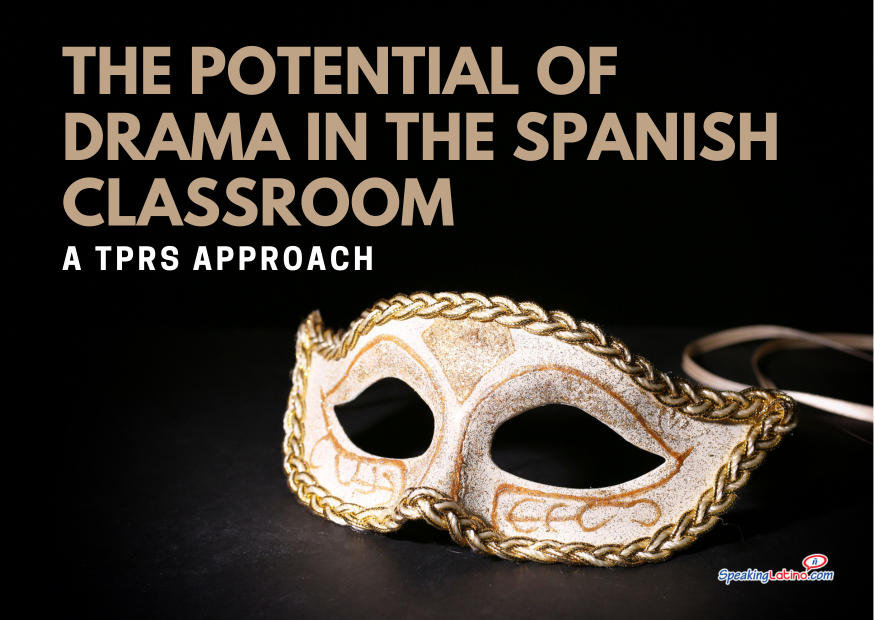
The content of this article is based on the presentation, The Magic of Drama in the Elementary Classroom (TPRS) by Carmen Reyes, which was part of the World Language Teacher Summit.
Infusing Drama into Language Learning
The infusion of drama into the elementary language classroom is not merely an artistic choice; it is a well-delineated educational strategy aimed at enhancing the efficacy of language acquisition among young learners. This approach provides students with a visceral, enjoyable, and multifaceted learning experience that caters to diverse learning needs.
Utilizing drama within a Teaching Proficiency through Reading and Storytelling (TPRS) framework elevates the traditional language learning experience by integrating creativity, context, and cognates into the curriculum, fostering deeper understanding and retention.
Emotions in Language Acquisition
Beginning the language learning journey with the teaching of emotions and feelings is a strategic move. It is through the universal expressions of joy, sadness, fear, and surprise that language transcends geographic boundaries. By engaging in a series of foundational activities like matching emotions with sentences, identifying emoticons, and organizing thoughts on a positive to negative spectrum, students are introduced to new vocabulary and syntactical constructs. This familiarization phase is critical, setting the stage for a more profound language immersion.
Interactive Learning through Charades of 3s and Broken Telephone
Interactive learning experiences such as "charades of 3s" are instrumental in driving home the emotional vocabulary in a visceral manner. When students embody these emotions, they learn much more than words—they learn expressions. Likewise, a variation of the game "broken telephone," where students act out and relay messages incorporating emotions, deepens their interpretive skills, ensuring the vocabulary becomes an active part of their communicative arsenal.
Storytelling: The Heartbeat of TPRS
Storytelling is at the core of TPRS, and integrating it with drama techniques generates a dynamic learning environment. Inquiry-based storytelling, structured through templates that outline the key elements of a narrative, requires students to harness their language skills to bring stories to life. Subsequently, students perform their tales without words, relying on body language and expressions, which enhances their storytelling prowess and interpretive reading as observers decipher the silent narratives.
Props as Storytelling Catalysts and Cognitive Enhancers
Props serve as cognitive anchors within the storytelling framework. Whether it's a piece of pizza or a bowl of spaghetti, these tangible elements provide students with a visual stimulus to accompany the target language nouns they are learning. This method complements silent acting where every gesture and prop becomes a clue to the unfolding story, prompting observers to read and react, thus solidifying their interpretive comprehension.
Proficiency Benchmarks to Measure Language Progress
The methodical integration of drama into the language curriculum means aligning activities with language proficiency benchmarks. Objectives such as increased student engagement, comprehension enhancement, and narrative composition capabilities are all met within this framework. Each drama-based activity is purposefully designed to contribute to the larger goal of language mastery.
From Vocabulary to Profound Language Abilities
The intricate journey from initial vocabulary comprehension to proficiency in writing and reading is a testament to the effectiveness of drama-infused TPRS. This strategy exemplifies how a language program can metamorphose from simple word recognition to intricate sentence structures, culminating in the fluent expression of thoughts and ideas in both written and oral forms.
Comprehensible Input Hypothesis
A cornerstone of TPRS is the comprehensible input hypothesis, which states that language is best acquired when the learner is exposed to content that is easily understandable. TPRS capitalizes on this by wrapping the language in engaging, context-rich stories, thereby encouraging mental associations that facilitate the retention and command of a new language.

Integrating storytelling with drama techniques generates a dynamic learning environment.
Dramatization as a Vehicular Tool for Comprehension
Drama activities inherently decrease affective filters, allowing students to participate without the usual inhibitions associated with learning a new language. An engaging drama-filled class is less about right or wrong answers and more about participation, exploration, and organic learning, enhancing not only the retention of language but also the joy of learning it.
The Engaging Power of Drama in Language Learning
Drama's final act in the TPRS classroom is an important one—it serves to heighten student interest, motivation, and self-assurance. As children engage in dramatization, they anchor their language learning in personally meaningful and memorable experiences. The confidence gained through successfully communicating in another language, even if through play, can be a transformative experience for a young learner.
FAQs About Using Drama in the Language Classroom
What specific drama activities can be to help students learn and practice language skills?
Specific drama activities used to help students learn and practice language skills include:
- Total Physical Response (TPR)
- Silent acting and pantomimes
- Observing and creating silent performances
- Using props to enhance storytelling
- Incorporating emotions and feelings in drama activities
- Recognizing and using cognates in storytelling
- Writing sentences describing emotions and actions
- Creating and performing stories based on templates
- Engaging in inquiry-based storytelling activities
- Encouraging students to act out scenarios and describe what they see
In what ways does drama increase student participation and engagement in language learning?
Drama increases student participation and engagement in language learning by:
- Providing interactive and hands-on experiences that make learning enjoyable and memorable
- Allowing students to actively engage in storytelling, acting out scenarios, and creating their own narratives .
- Encouraging students to use their language skills in a practical and meaningful context.
- Fostering a creative and dynamic learning environment that captures students' interest and imagination.
- Offering opportunities for students to express themselves through non-verbal communication, such as gestures and facial expressions.
- Promoting collaboration and teamwork as students work together to perform and interpret stories.
- Providing a platform for students to showcase their language proficiency through acting and storytelling.
- Creating a low-pressure setting where students can experiment with language without fear of making mistakes.
- Enhancing students' confidence in using new vocabulary and language structures in a supportive and interactive setting.
- Making language learning more engaging and relevant by connecting it to real-life scenarios and experiences.

An engaging drama-filled class is less about right or wrong answers and more about participation, exploration, and organic learning.
What results have been seen in students' language skills after implementing these innovative approaches?
After implementing innovative approaches such as drama activities in language learning, the following results have been observed in students' language skills:
- Increased interest and engagement in language acquisition, leading to higher motivation and participation.
- Improved comprehension and retention of vocabulary and language structures through practical application in storytelling and silent acting.
- Enhanced writing and reading skills as students practice presentational writing and interpretive reading in real-life scenarios.
- Development of confidence in using new vocabulary in context and expressing emotions and actions through drama activities.
- Greater proficiency in recognizing and using cognates and high-frequency words in storytelling and performances.
- Improved ability to create and perform stories based on templates and inquiry-based storytelling activities.
- Strengthened language output and communication skills as students act out scenarios and describe what they see in target language.
- Increased creativity and critical thinking skills as students engage in creating and interpreting stories through drama.
- Enhanced language fluency and natural expression through interactive and multi-sensory learning experiences.
- Overall, the implementation of drama activities has led to a more holistic and effective language learning experience for students, resulting in improved language skills and proficiency
The Evolution of Elementary Language Learning Through Drama
The foregoing discussion has illustrated the myriad ways in which drama can revolutionize language learning in an elementary setting. By integrating TPRS with dramatic activities, educators are equipped with a powerful blend of techniques that make learning a language not just an academic exercise but a journey filled with discovery, creativity, and excitement.
Embracing the magic of drama within a TPRS framework sets the stage for a holistic language learning experience that nurtures the communicative, interpretative, and expressive abilities of every student.
Discover more language teaching techniques to help you in your classroom.